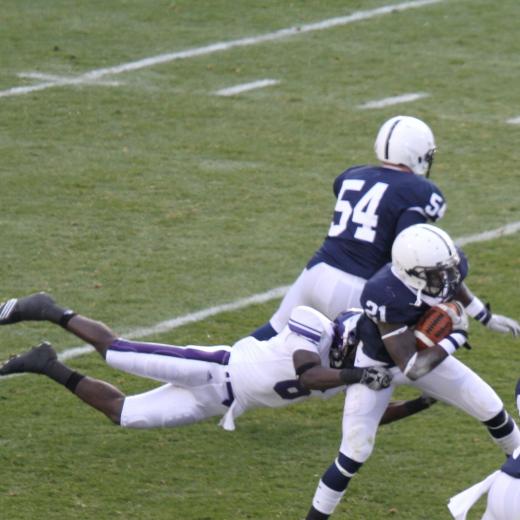Why do we love football?
According to some of the writers who have been covering the NFL’s crackdown on head-cracking tackles, we love it because we are bloodthirsty savages who are thrilled by violence. Lose the violence, these commentators say, and you lose the audience.
I don’t think this is true. I think we love football for the same reason we love art or ballet or the way oak trees look on a sunny afternoon in autumn: because it is beautiful.
Admitting that we respond to the beauty of football might be more embarrassing than admitting that we respond to the violence of football. Consider the hyper-masculine opening of every NFL telecast – the martial music, the basso profundo voice-over (the same voice that’s used to sell rugged trucks and chuggable beers), the crashing and shattering helmets. It says: Never mind that you’re all reclining in your La-Z-Boys and your Barcaloungers. You appreciate these tough guys because you’re a bunch of tough guys yourselves. It doesn’t say: You appreciate the balletic grace of these athletes because you are connoisseurs of beauty.
In fact, though, a football game, indeed, every sports event, is an aesthetic extravaganza, beginning with the field of play itself. A thousand baseball writers have rhapsodized on the symmetry of the diamond and the lush green color of the turf. The gridiron has a similar appeal.
I suppose an evolutionary biologist would tell us that suburbanites spend bazillions on lawn care and urbanites seek respite from the concrete canyons in city parks because green grass signaled abundant food and water to our food-questing ancestors. I supposed they’d say we respond to symmetry from the moment we set eyes on the symmetrical faces of our mothers as infants. In any case, we love the beauty of the field of play.
Then there is the beauty of uniforms: the brilliant colors and dazzling whiteness of jerseys, the shininess of helmets, the meaning-saturated letters and numbers and logos on jersey, helmet and field. We’re all typophiles – lovers of the symbol systems we use to order a wild world. Even Yankee haters concede that there are few things spiffier than those Yankee pinstripes and that interlocking NY logo. For proof that the sartorial is an important component of the sports experience, consider the howls of protest that greet attempts to add flair to the Nittany Lions’ vanilla uniforms. Or go to Uni Watch on the ESPN website.
Above all, the pleasure of sport is the pleasure of seeing what trained and gifted athletes can do with the sack of muscle and bone that is the human body. The most thrilling plays in football aren’t the bone-crushing tackles, but the sideline or back-of-the-end-zone catches. These are the plays where a receiver leaps, snatches the spiraling ball out of the air and somehow manages to touch both toes in bounds before his momentum carries him out of bounds. It is a thing of beauty, as graceful as any choreographed move in the world of dance.
Also lovely:
- When a quarterback “threads the needle,” throwing a pass to the exact and only spot he could have thrown it where it could be caught by his own guy and not by a defender.
- When a runner spins or fakes or accelerates in a way that leaves his pursuers grasping at air rather than at him.
- When a guy like Ben Roethlisberger completes a pass with pass rushers draped over him like wet laundry on a drying rack.
- When a guy like Adrian Peterson appears to be bottled up and then drags about a half-ton of human flesh another 10 yards down the field or breaks away from the pile altogether.
- When a guy like Troy Polamalu gets to the ball carrier not by going around people but by springing into the air and flying over them.
I suppose you could still have leaping catches and precision passes if pro football suddenly went from tackle to two-hand touch. Forget all these other moments, though: They’re predicated on the need to tackle, or to break tackles. And when very large men “gallop terribly against each other’s bodies,” as the poet James Wright put it, terrible injuries are bound to occur.
But acknowledging our complicity in these injuries is not the same as rooting for them to happen. Which is why, when I read in The New York Times that violence “is the essential ingredient that attracts fans to football,” or that it is “the NFL’s primary product,” I have to disagree.
When, on that beautiful expanse of green grass, an irresistible force in a shiny helmet meets an immovable object in another shiny helmet, I don’t exult. I cringe.



